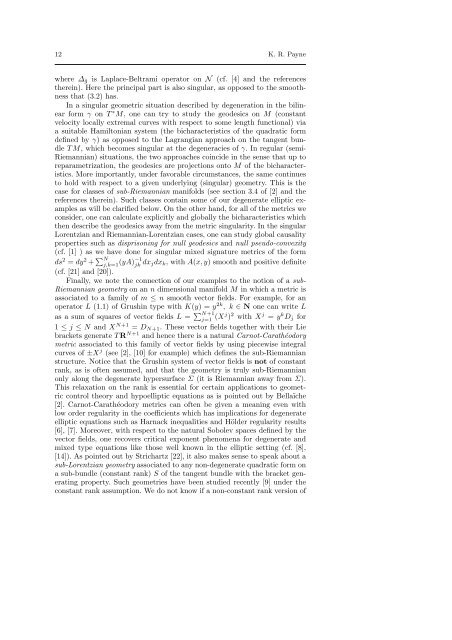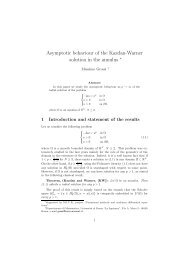Singular metrics and associated conformal groups underlying ...
Singular metrics and associated conformal groups underlying ...
Singular metrics and associated conformal groups underlying ...
You also want an ePaper? Increase the reach of your titles
YUMPU automatically turns print PDFs into web optimized ePapers that Google loves.
12 K. R. Payne<br />
where ∆˜g is Laplace-Beltrami operator on N (cf. [4] <strong>and</strong> the references<br />
therein). Here the principal part is also singular, as opposed to the smoothness<br />
that (3.2) has.<br />
In a singular geometric situation described by degeneration in the bilinear<br />
form γ on T ∗ M, one can try to study the geodesics on M (constant<br />
velocity locally extremal curves with respect to some length functional) via<br />
a suitable Hamiltonian system (the bicharacteristics of the quadratic form<br />
defined by γ) as opposed to the Lagrangian approach on the tangent bundle<br />
T M, which becomes singular at the degeneracies of γ. In regular (semi-<br />
Riemannian) situations, the two approaches coincide in the sense that up to<br />
reparametrization, the geodesics are projections onto M of the bicharacteristics.<br />
More importantly, under favorable circumstances, the same continues<br />
to hold with respect to a given <strong>underlying</strong> (singular) geometry. This is the<br />
case for classes of sub-Riemannian manifolds (see section 3.4 of [2] <strong>and</strong> the<br />
references therein). Such classes contain some of our degenerate elliptic examples<br />
as will be clarified below. On the other h<strong>and</strong>, for all of the <strong>metrics</strong> we<br />
consider, one can calculate explicitly <strong>and</strong> globally the bicharacteristics which<br />
then describe the geodesics away from the metric singularity. In the singular<br />
Lorentzian <strong>and</strong> Riemannian-Lorentzian cases, one can study global causality<br />
properties such as disprisoning for null geodesics <strong>and</strong> null pseudo-convexity<br />
(cf. [1] ) as we have done for singular mixed signature <strong>metrics</strong> of the form<br />
ds 2 = dy 2 + N<br />
j,k=1 (yA)−1<br />
jk dxjdxk, with A(x, y) smooth <strong>and</strong> positive definite<br />
(cf. [21] <strong>and</strong> [20]).<br />
Finally, we note the connection of our examples to the notion of a sub-<br />
Riemannian geometry on an n dimensional manifold M in which a metric is<br />
<strong>associated</strong> to a family of m ≤ n smooth vector fields. For example, for an<br />
operator L (1.1) of Grushin type with K(y) = y 2k , k ∈ N one can write L<br />
as a sum of squares of vector fields L = N+1<br />
j=1 (Xj ) 2 with X j = y k Dj for<br />
1 ≤ j ≤ N <strong>and</strong> X N+1 = DN+1. These vector fields together with their Lie<br />
brackets generate T R N+1 <strong>and</strong> hence there is a natural Carnot-Carathéodory<br />
metric <strong>associated</strong> to this family of vector fields by using piecewise integral<br />
curves of ±X j (see [2], [10] for example) which defines the sub-Riemannian<br />
structure. Notice that the Grushin system of vector fields is not of constant<br />
rank, as is often assumed, <strong>and</strong> that the geometry is truly sub-Riemannian<br />
only along the degenerate hypersurface Σ (it is Riemannian away from Σ).<br />
This relaxation on the rank is essential for certain applications to geometric<br />
control theory <strong>and</strong> hypoelliptic equations as is pointed out by Bellaïche<br />
[2]. Carnot-Carathéodory <strong>metrics</strong> can often be given a meaning even with<br />
low order regularity in the coefficients which has implications for degenerate<br />
elliptic equations such as Harnack inequalities <strong>and</strong> Hölder regularity results<br />
[6], [7]. Moreover, with respect to the natural Sobolev spaces defined by the<br />
vector fields, one recovers critical exponent phenomena for degenerate <strong>and</strong><br />
mixed type equations like those well known in the elliptic setting (cf. [8],<br />
[14]). As pointed out by Strichartz [22], it also makes sense to speak about a<br />
sub-Lorentzian geometry <strong>associated</strong> to any non-degenerate quadratic form on<br />
a sub-bundle (constant rank) S of the tangent bundle with the bracket generating<br />
property. Such geometries have been studied recently [9] under the<br />
constant rank assumption. We do not know if a non-constant rank version of








